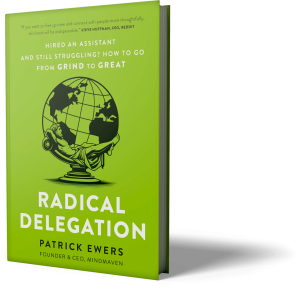After years of helping people leverage their networks more successfully, we came to believe in a universal truth: people like to meet in person for coffee or lunch. They will wait and get on someone’s calendar so they can meet in a physical setting, rather than having a phone call now.
The reason is simple. In-person meetings are better because we communicate with physical presence and body language, as well as through the tone of our voice. This allows us to connect more meaningfully when we’re trying to develop relationships. Because of this, we believe these meetings will never go away. We will still always try to meet in person.
Meaningful connections are made when we are mindful of our body language and tone of voice. Tweet this
Having said this, I recommend emulating this experience in a skillful way by becoming more efficient when you’re meeting people. I’m talking about having video meetings. You can still get about 95% of the experience you would have from meeting the person in a physical setting. You will also gain time savings of 100% on a one-hour meeting because you won’t have to travel anywhere. (This assumes that for an hour-long meeting you have up to 30 minutes of travel time to and from that meeting, resulting in a 2-hour total investment of time for a single meeting.) If you’re interested in gaining some skills and learning how to do video calls really well, we recommend learning one simple way to make video calls more personal to deliver a great experience.
In video calls, if you do it right, you can deliver up to 95% of the experience of meeting in person. Tweet this
Since we often still meet people in person, we need to get the most value out of the time we’re investing when meeting them. The most important and cost effective way to get your mindshare up to 100% is to touch people more frequently during the time between meetings. If you can do this consistently and regularly, you’ll harvest great opportunities from your network. When you’ve invested time into a meeting, make sure you touch this person more often until the next time you meet, which might be 3 to 6 months away.
So the question is: how do you touch people more often?
Like so many things we do here at Mindmaven, it’s simple and based on common sense. Use the small talk time that comes with every meeting not just to talk about weather and traffic but to go in and really understand two things:
- His or her professional interests and passions.
- What the person’s biggest professional challenge is right now.
When you learn about someone’s professional challenge, you’ll instantly have an idea how your knowledge and network can help this person solve the problem. What you have to offer might not be a perfect solution, but it doesn’t have to be. It just has to be relevant enough and delivered in a genuine way. However, it allows you to touch this person in 2 weeks, 4 weeks, or 6 weeks, with something that your contact will most likely find meaningful.
For example, you might meet somebody who says, “Hiring is one of my biggest challenges. Finding great talent is really difficult to do.” He’s interested in hiring a VP of Engineering because he specifically wants to scale his tech-startup. It might be very hard for you to help him find that particular engineering resource; however, you remember an article you read about startups hiring people out of Eastern Europe. They fly someone into town and spend two weeks working with that person. After two weeks, they either make them an offer, or not. If the offer is made, the individual flies back. They start sorting out the visa but work with the individual remotely. This gives startups access to markets with a lot of untapped high-quality talent. This is a great example of something you could send a contact who has these hiring challenges. You see, this example might be too outside of the box to act on, but wouldn’t you agree this person still would find this relevant and appreciate you sending it? Keep in mind, we just need to be top of mind, and this certainly would be achieved. Let’s look at this in more detail.
When trying to help, intent is 90% of value perceived. Tweet this.
What are the scenarios? The best thing that can happen, of course, is he reads the article, thinks it’s a great idea and starts doing it. He grows his team much faster than he did before. If this happens, he will attribute this success to you. Alternately, he could read the article and find it very intriguing. He has one or two other ideas he is trying, but he appreciates that you sent it. This is reward enough for you as well. Lastly, he could see the email, see the links, but never read it. The point is he’ll experience the same amount of value because he appreciates you cared enough to send it to him. In most cases, intent is 90% of the perceived value, and the reason you’re sending this article is you want to stay top of mind with him. You can read about the benefits of staying top of mind in Five Basic Ways to Get Started With NRM. In the end, you’ll achieve your objective with the added benefit of deepening your relationship.
Collecting Information in Meetings:
- During synchronous communication (i.e. physical meetings and calls), find out the challenges people face and what they want to be doing. Discover their personal interests and passions. It’s easier to talk about those, and very often they can offer more. The key aspect is to make sure you identify what they’re passionate about and try to find things you share in common. You’ll understand why this is important after reading Tip #1 in our NRM Top 5 Tip Series about improving your social media presence. If you share something in common, the likelihood of becoming meaningful, relevant, and valuable to a person goes up dramatically. It becomes so much easier to communicate. This is why it’s important to collect this information, but we’re not done yet!
- It is very important not to forget the information you collect. Unfortunately, the same principles of mindshare apply to this information: it will decay over time unless we find a reasonable way to store it and a pragmatic way to access it. What we did is we invented a concept called a meeting debrief that you should invest in as part of meeting somebody in the first place. If you want to learn more about the benefits of meeting debriefs, please read our meeting debrief blog post.
To sum it up, you’ll set up a system where you can store these professional challenges, personal interests and passions in an easy accessible way. (We recommend using Contactually.) Then you become very disciplined at collecting this information after the meeting and putting it into your new system.[/fusion_builder_column][/fusion_builder_row][/fusion_builder_container]


